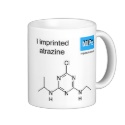|
|
Reference type: Journal
Authors: Kyzas GZ, Nanaki SG, Koltsakidou A, Papageorgiou M, Kechagia M, Bikiaris DN, Lambropoulou DA
Article Title: Effectively designed molecularly imprinted polymers for selective isolation of the antidiabetic drug metformin and its transformation product guanylurea from aqueous media.
Publication date: 2015
Journal: Analytica Chimica Acta
Volume: 866
Page numbers: 27-40.
DOI: 10.1016/j.aca.2015.01.045
Alternative URL: http://www.sciencedirect.com/science/article/pii/S0003267015001026
Abstract: In the present study, two novel molecularly imprinted polymers (MIPs) with remarkable recognition properties for metformin and its transformation product, guanylurea, have been prepared for their selective, enrichment, isolation and removal from aqueous media. The prepared adsorbents were characterized by Fourier transform infrared spectroscopy (FTIR), scanning electron microscopy (SEM) and swelling experiments. The performance of the prepared MIPs was evaluated by various parameters including the influence of pH, contact time, temperature and initial compound concentration. The effects on the adsorption behavior of the removal process parameters were studied and the equilibrium data were fitted by the Langmuir and Freundlich models. Due to the imprinting effect, adsorption performance of MIPs was always superior to its corresponding NIP (non-imprinted polymer), with maximum adsorption capacity ~80 mg g-1 for both MIPs. Stability and reusability of the MIPs up to the 5th cycle meant that they could be applied repeatedly without losing substantial removal ability. In the next step, the prepared MIP nanoparticles were evaluated as sorbents in a dispersive solid phase extraction (D-SPE) configuration for selective enrichment and determination of metformin and guanylurea in different aqueous matrices. Under the working extraction conditions, the D-SPE method showed good linearity in the range of 50-1000 ng L-1, repeatability of the extractions (RSD 2.1-5.1%, n = 3), and low limits of detection (1.5-3.4 ng L-1). The expanded uncertainty of the data obtained was estimated following a bottom-up approach. The proposed method combined the advantages of MIPs and D-SPE, and it could become an alternative tool for analyzing the residues of METF and its transformation product GUA in complex water matrices, such as wastewaters
Template and target information: metformin, METF
Author keywords: adsorption, Dispersive Solid Phase Extraction, Guanylurea, metformin, molecularly imprinting, Uncertainty
|


 multi MIPs tote bag
multi MIPs tote bag







 MI cryptic logo mousepad
MI cryptic logo mousepad







 Atrazine template mug
Atrazine template mug






